1.1 The global distribution of tectonic hazards can be explained by plate boundary and other tectonic processes.
5.0(1)
5.0(1)
Card Sorting
1/23
Earn XP
Description and Tags
Study Analytics
Name | Mastery | Learn | Test | Matching | Spaced |
|---|
No study sessions yet.
24 Terms
1
New cards
Distribution of earthquakes around the world
* Most earthquake zones are found at or close to tectonic boundaries
* Around 70% of earthquakes are found around the pacific ring of fire
* The most powerful earthquakes are associated with convergent or conservative boundaries
* Some but few earthquakes occur away from boundaries, due to hotspots
* Around 70% of earthquakes are found around the pacific ring of fire
* The most powerful earthquakes are associated with convergent or conservative boundaries
* Some but few earthquakes occur away from boundaries, due to hotspots
2
New cards
The oceanic fracture zone (OFZ) -
A belt of activity through the oceans along the mid-ocean ridges, coming ashore in Africa, the Red Sea, the Dead Sea rift and California.
3
New cards
The continental fracture zone (CFZ)
A belt of activity following the mountain ranges from Spain via the Alps, to the Middle East, the Himalayas to the East Indies and then circumscribing the Pacific.
4
New cards
Causes of Earthquakes
Earthquakes are a sudden release of stored energy.
* As two plates move past each other they inevitably 'stick'. This allows strain to build up over time and the plates are placed under increasing stress.
* Earthquakes are generated because of the sudden release of the stress - 'slip-stick behaviour'. A pulse of energy radiates out in all directions from the earthquake focus. In some cases the earthquake motion displaces the surface, so a fault scarp can be seen.
* As two plates move past each other they inevitably 'stick'. This allows strain to build up over time and the plates are placed under increasing stress.
* Earthquakes are generated because of the sudden release of the stress - 'slip-stick behaviour'. A pulse of energy radiates out in all directions from the earthquake focus. In some cases the earthquake motion displaces the surface, so a fault scarp can be seen.
5
New cards
Distribution of volcanoes
These also occur at, or close to tectonic plate boundaries, with the exception of hotspots, such as that by Hawaii.
There are about 500 active volcanoes throughout the world and on average about 50 erupt each year.
There are about 500 active volcanoes throughout the world and on average about 50 erupt each year.
6
New cards
Tsunami distribution
The global distribution of tsunami is fairly predictable in terms of source areas, with around 90% of all events occurring within the Pacific Basin, associated with activity at the plate margins.
Most are generated at subduction zones (convergent boundaries), particularly off the Japan-Taiwan island arc, South America and the Aleutian Islands (25% of all historical events have been recorded in this geographic region.
Most are generated at subduction zones (convergent boundaries), particularly off the Japan-Taiwan island arc, South America and the Aleutian Islands (25% of all historical events have been recorded in this geographic region.
7
New cards
Causes of tsunamis
Tsunami are generated when a sub-marine earthquake displaces the sea bed vertically as a result of movement along a fault line at a subduction zone.
The violent motion displaces a large volume of water in the ocean water column, which then moves outwards in all directions from the point of displacement.
Sub-marine earthquakes that occur close to the shoreline can generate intense ground shaking damage, followed by the damage from the subsequent tsunami.
The violent motion displaces a large volume of water in the ocean water column, which then moves outwards in all directions from the point of displacement.
Sub-marine earthquakes that occur close to the shoreline can generate intense ground shaking damage, followed by the damage from the subsequent tsunami.
8
New cards
Divergent -- Oceanic-Oceanic:
\n Plates are __moving away__ from each other.
Rising convection currents bring magma to the surface resulting in small, basaltic eruptions, creating new oceanic plate. Minor, shallow earthquakes. \n *E.g. Mid-Atlantic ridge at Iceland*
Rising convection currents bring magma to the surface resulting in small, basaltic eruptions, creating new oceanic plate. Minor, shallow earthquakes. \n *E.g. Mid-Atlantic ridge at Iceland*
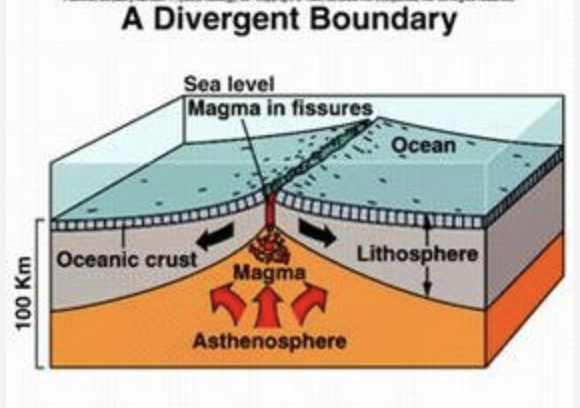
9
New cards
\
Divergent -- Continent-Continent
Divergent -- Continent-Continent
Plates are __moving away__ from each other.
\n A geologically recent mantle plume splits a continental plate to create a new ocean basin. Basaltic volcanoes and minor earthquakes. \n *E.g. African Rift Valley/Red Sea*
\n A geologically recent mantle plume splits a continental plate to create a new ocean basin. Basaltic volcanoes and minor earthquakes. \n *E.g. African Rift Valley/Red Sea*
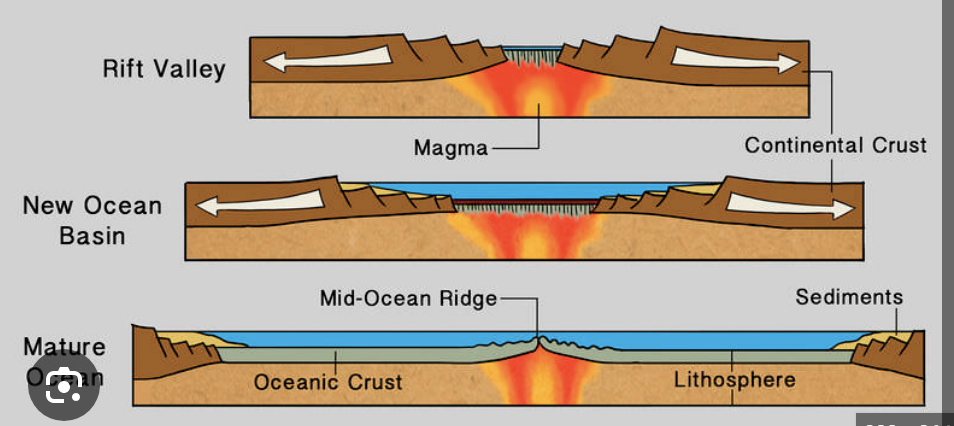
10
New cards
Fracture zones
Tensional forces open cracks and faults between the two plates (called a 'fracture zone'). These create pathways for magma to move towards the surface and erupt, creating new oceanic plate.
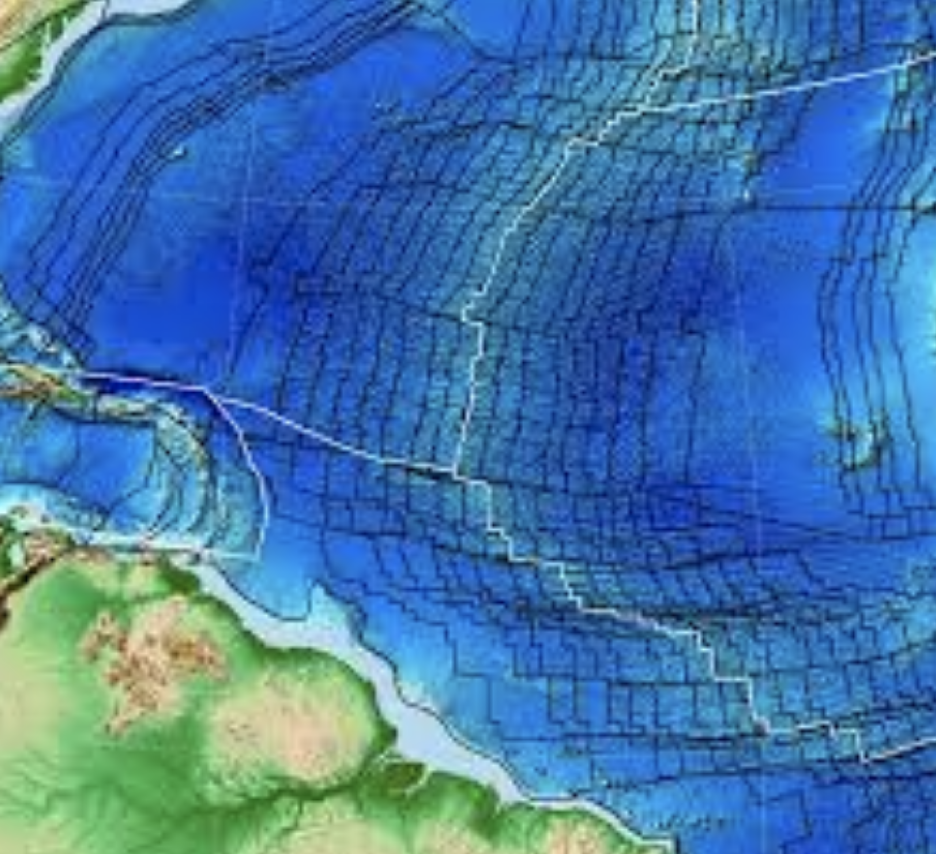
11
New cards
Causes of divergent plate boundaries
The mantle convection forces tectonic plates apart.
Mantle convection forces plates apart at constructive plate margins. Tensional forces open cracks and faults between the two planes.
Mantle convection forces plates apart at constructive plate margins. Tensional forces open cracks and faults between the two planes.
12
New cards
Earthquakes at divergent plate boundaries
Earthquakes are shallow, less than 60 km deep and have low magnitudes of under 5.0.
13
New cards
Convergent -- Oceanic-Oceanic
Plates move __towards__ each other. \n One oceanic plate is sub-ducted beneath another, generating frequent earthquakes and a curving (arc) chain of volcanic islands, which erupt. \n *E.g. the Aleutian Islands, Alaska*

14
New cards
Convergent -- Continent-Continent
\n The collision of two continental landmasses, create a mountain belt as the landmasses crumple, and magma is generated at depth. Infrequent major earthquakes distributed over a large area. Eruptions are possible, but as the magma cools and solidifies beneath the surface they are rare. \n *E.g. the Himalayas*
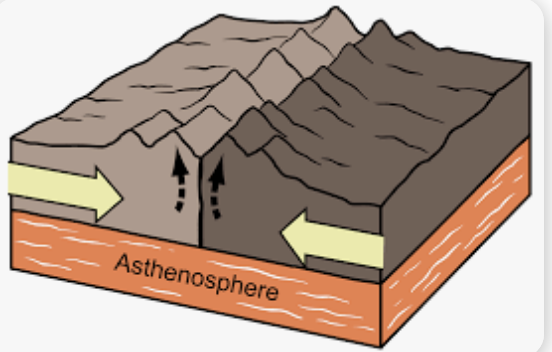
15
New cards
The Himalayas - Convergent boundary example
* Two continental plates are in collision at the Himalaya mountains (the Indo-Australian and Eurasian plates), which began 52 million years ago.
* As both continental plates have the same low density, subduction is not possible. Instead, the plates have 'crumpled', creating enormous tectonic uplift in the form of the Himalaya and Tibetan Plateau.
* Collision zones are cut by huge thrusts that generate shallow, high magnitude earthquakes such as in Kashmir in 2005 and Nepal in 2015.
* As both continental plates have the same low density, subduction is not possible. Instead, the plates have 'crumpled', creating enormous tectonic uplift in the form of the Himalaya and Tibetan Plateau.
* Collision zones are cut by huge thrusts that generate shallow, high magnitude earthquakes such as in Kashmir in 2005 and Nepal in 2015.
16
New cards
Convergent -- Oceanic-Continent
Plates move t__owards__ eachother.
An oceanic plate is subducted under a continental plate, creating a volcanic mountain range, frequent large earthquakes and violent eruptions. \n *E.g. The Andean Mountains*
An oceanic plate is subducted under a continental plate, creating a volcanic mountain range, frequent large earthquakes and violent eruptions. \n *E.g. The Andean Mountains*

17
New cards
Causes of convergent boundaries -- Oceanic-Continent
* Mantle convection pulls plates towards subduction zones, whilst the other end of the plate is being pulled away at a divergent margin. (So basically, there's a constructive margin and the plate is being pulled away from it, whilst the other end of the plate is being subducted.)
* Cold, dense oceanic plate is subducted beneath less dense continental plate; the density of the oceanic plate pulls itself into the mantle.
* The descending plate begins to melt at depth by a process called wet partial melting. This generates magma with a high gas and silica content, which erupts with explosive force
* Cold, dense oceanic plate is subducted beneath less dense continental plate; the density of the oceanic plate pulls itself into the mantle.
* The descending plate begins to melt at depth by a process called wet partial melting. This generates magma with a high gas and silica content, which erupts with explosive force
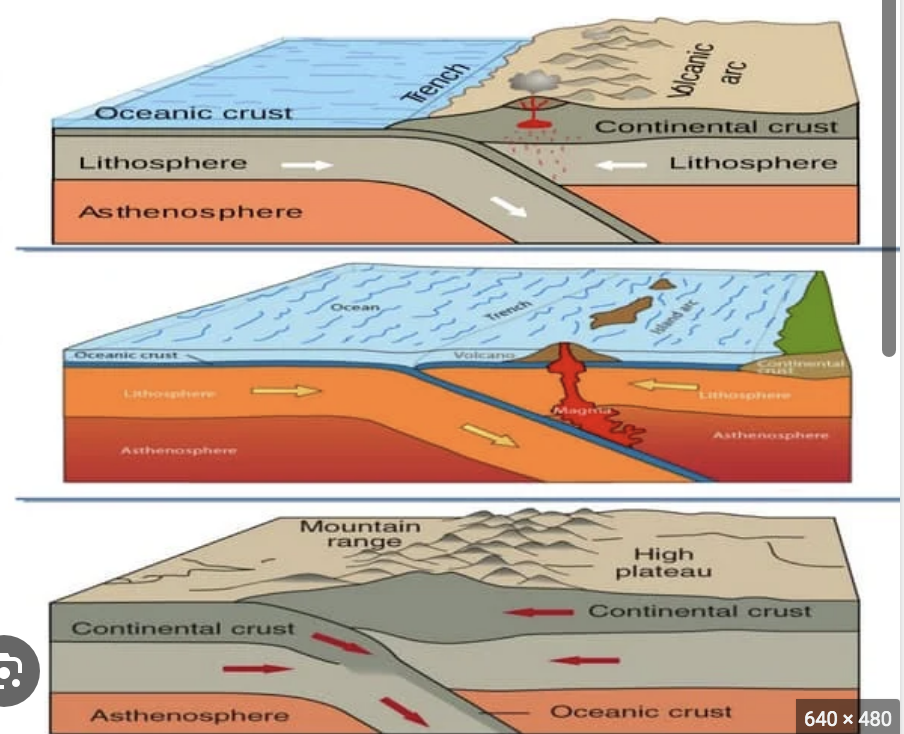
18
New cards
Earthquakes at convergent boundaries (destructive?)
Earthquakes at subduction zones occur at a range of focal depths from 10 km to 400 km, following the line of the subducting plate. (The Benioff Zone). It can yield earthquakes up to a magnitude of 9.0.
19
New cards
Conservative -- Oceanic-Continent
\n \n Plates slide past each other, along zones known as transform faults. Frequent earthquakes, with a shallow focal depth, so they can be very destructive if they are high magnitude. No volcanic activity.
*E.g. San Andreas Fault, extends 1,200 km across California*
*E.g. San Andreas Fault, extends 1,200 km across California*
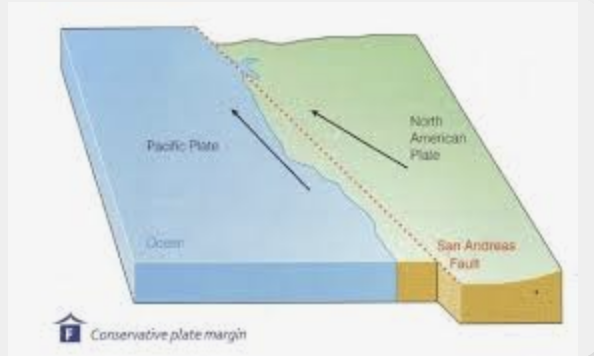
20
New cards
What two factors do plate boundaries rely upon?
* **Motion**: Whether the plates are moving apart (divergent), colliding (convergent) or sliding past each other, (conservative or transform).
* **Plate type:** whether the tectonic plates are oceanic or continental. Oceanic plates make up the ocean floor and are high density, basaltic rock, but only 7-10 km thick. Continental plates make up the Earth's landmasses and are much thicker at 25-70 km but made of less dense, granitic rock.
* **Plate type:** whether the tectonic plates are oceanic or continental. Oceanic plates make up the ocean floor and are high density, basaltic rock, but only 7-10 km thick. Continental plates make up the Earth's landmasses and are much thicker at 25-70 km but made of less dense, granitic rock.
21
New cards
Itra-plate Earthquakes
Earthquakes can occur in mid-plate settings, usually associated with major ancient fault lines being re-activated by tectonic stresses.
For example, the New Madrid Seismic Zone on the Mississippi River generates earthquakes up to magnitude 7.5, but is thousands of miles from the nearest plate boundary.
For example, the New Madrid Seismic Zone on the Mississippi River generates earthquakes up to magnitude 7.5, but is thousands of miles from the nearest plate boundary.
22
New cards
Hotspot volcanoes
* Isolated plumes of convecting heat, called mantle plumes, rise towards the surface, generating basaltic volcanoes that tend to erupt continuously.
* A mantle plume is stationary, but the tectonic plate above moves slowly over it.
* Over millennia, this produces a chain of volcanic islands, with extinct ones most distant from the plume's location.
* A mantle plume is stationary, but the tectonic plate above moves slowly over it.
* Over millennia, this produces a chain of volcanic islands, with extinct ones most distant from the plume's location.
23
New cards
Magma Plume
Concentrated areas of heat convection. At plate boundaries they are sheet-like, whereas at hot spots they are column like.
24
New cards
What is plate theory
Plate theory is this new idea that hotspot volcanoes dont occur due to hotspots or magma plumes, but are infact the result of weak spots in plates, due to fracture zones and other stress/strain related weaknesses.
* The heat of the mantle is the same equally on the crust
* Some parts of the crust allowing the mantle to push magma through
* A volcano emerges
* The heat of the mantle is the same equally on the crust
* Some parts of the crust allowing the mantle to push magma through
* A volcano emerges